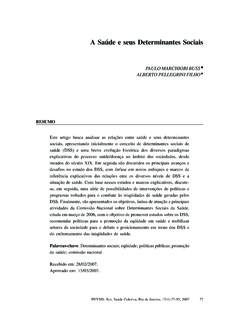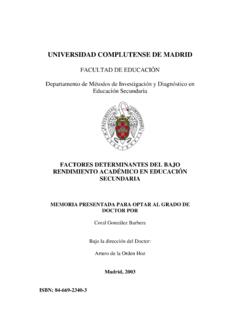Transcription of Public Health Social determinants of health …
1 For personal use. Only reproduce with permission from Elsevier Ltd Public HealthThere are gross inequalities in Health betweencountries. Life expectancy at birth, to take onemeasure, ranges from 34 years in Sierra Leone to81 9 years in countries, too, there arelarge inequalities a 20-year gap in life expectancybetween the most and least advantaged populations inthe USA, for welcome response to thesehealth inequalities is to put more effort into the controlof major diseases that kill and to improve ,4A second belated response is to deal with issue is the thrust of the MillenniumDevelopment ,6 These goals challenge the worldcommunity to tackle poverty in the world s poorestcountries. Included in these goals is reduction of childmortality, the Health outcome most sensitive to theeffects of absolute material reduce inequalities in Health across the world thereis need for a third major thrust that is complementary todevelopment of Health systems and relief of poverty: totake action on the Social determinants of Health .
2 Suchaction will include relief of poverty but it will have thebroader aim of improving the circumstances in whichpeople live and work. It will, therefore, address not onlythe major infectious diseases linked with poverty ofmaterial conditions but also non-communicablediseases both physical and mental and violentdeaths that form the major burden of disease and deathin every region of the world outside Africa and addsubstantially to the burden of communicable disease insub-Saharan Africa. To understand the Social determinants of Health ,how they operate, and how they can be changed toimprove Health and reduce Health inequalities, WHOis setting up an independent Commission on SocialDeterminants of Health , with the mission to linkknowledge with action (panel 1). Public policy bothnational and global should change to take intoaccount the evidence on Social determinants of healthand interventions and policies that will address introduction to the Commission s task lays outthe problems of inequalities in Health that theCommission will address and the approach that it willtake.
3 This report will argue that Health status should beof concern to all policy makers, not merely thosewithin the Health sector. If Health of a populationsuffers it is an indicator that the set of socialarrangements needs to change. Simply, theCommission will seek to have Public policy based on avision of the world where people matter and socialjustice is in Health between and withincountries: poverty and inequality A catastrophe on the scale of the Indian Oceantsunami rightly focuses attention on the susceptibilityof poor and vulnerable populations to natural is no less important to keep on the agenda the moreenduring problem of inequalities in Health amongcountries. Children Under-5 mortality varies from 316 per 1000 livebirthsin Sierra Leone to 3 per 1000 livebirths in Iceland,4 per 1000 livebirths in Finland, and 5 per 1000livebirths in 16 countries (12 in Africa), childmortality rose in the 1990s,7by 43% in Zimbabwe, 52%in Botswana, and 75% in 2005; 365: 1099 104 See Commentpage 1005 International Centre for Healthand Society, University CollegeLondon, 1 19 Torrington Place,London WC1E 6BT, UK(Prof Sir M 365 March 19, 20051099 Social determinants of Health inequalitiesMichael MarmotThe gross inequalities in Health that we see within and between countries present a challenge to the world.)
4 That thereshould be a spread of life expectancy of 48 years among countries and 20 years or more within countries is notinevitable. A burgeoning volume of research identifies Social factors at the root of much of these inequalities in determinants are relevant to communicable and non-communicable disease alike. Health status, therefore,should be of concern to policy makers in every sector, not solely those involved in Health policy. As a response to thisglobal challenge, WHO is launching a Commission on Social determinants of Health , which will review the evidence,raise societal debate, and recommend policies with the goal of improving Health of the world s most vulnerablepeople. A major thrust of the Commission is turning Public - Health knowledge into political 1: The Commission on Social determinants of HealthThe Commission will not only review existing knowledge butalso raise societal debate and promote uptake of policies thatwill reduce inequalities in Health within and betweencountries.
5 The Commission s aim is, within 3 years, to set solidfoundations for its vision: the societal relations and factorsthat influence Health and Health systems will be visible,understood, and recognised as important. On this basis, theopportunities for policy and action and the costs of notacting on these Social dimensions will be widely known anddebated. Success will be achieved if institutions working inhealth at local, national, and global level will be using thisknowledge to set and implement relevant Public policyaffecting Health . The Commission will contribute to a long-term process of incorporating Social determinants ofhealth into planning, policy and technical work at personal use. Only reproduce with permission from Elsevier Ltd Public HealthFigure 1 shows under-5 mortality rates for fourcountries with households classified according tosocioeconomic quintile. Child mortality varies countries, not only is child mortalityhighest among the poorest households but also there isa Social gradient: the higher the socioeconomic level ofthe household the lower the mortality Differences in adult mortality among countries arelarge and growing.
6 Figure 2 shows probability of deathbetween age 15 and 60 years by region of the worldbetween 1970 and rose in Africa and inthe countries of central and eastern Europe whereas itdeclined in the world as a whole. By 2002, for example,men in the high mortality countries of Europe hadmore than 40% probability of death between age 15and 60 years compared to a 25% probability insoutheast Asia. These data are for regions. Amongcountries, the differences are even more dramatic. Theprobability of a man dying between age 15 and 60 yearsis 8 3% in Sweden, 82 1% in Zimbabwe, and 90 2%in particularly telling example of Health inequalitieswithin countries is the 20-year gap in life expectancybetween Australian Aboriginal and Torres StraitIslander peoples life expectancy is 56 3 years formen and 62 8 years for women and the men in this population would lookunhealthy in India (male life expectancy 60 1 years)whereas Australian life expectancy is among thehighest in the world, marginally behind Iceland,Sweden, and Japan.
7 The poor Health of Aboriginal andTorres Strait Islander peoples is not the result of a highrate of child deaths. Infant mortality is 12 7 per1000 livebirths. This figure is high by Australianstandards, but on a scale from Iceland to Sierra Leone,it is much closer to Iceland than to Sierra Leone. Theshortened life expectancy of Aboriginal and TorresStrait Islander peoples results from mortality in adultsfrom non-communicable disease and injury. In thissense, the population is typical of the world healthpicture. Of the 45 million deaths among adults age15 years and older in 2002, 32 million were due to non-communicable disease and a further 4 5 million toviolent and Torres Strait Islander peoples are asocially excluded minority within their country. Butpoor Health is not confined to poor populations orthose who are socially excluded. As with childmortality, there is a socioeconomic gradient in adultmortality rates within countries.
8 Figure 3 shows that inBangladesh, adult mortality rates vary inversely withlevel of gradient in mortality is quiteremarkable. Within rich countries, with strikinglydifferent material conditions from Bangladesh, there isa Social gradient in mortality prompting considerationof the causal links between status and the Social gradient in poor countries can beattributed to the same causal pathways is an urgenttask for review. It is especially important because, inmany countries, inequalities in Health have 15In Russia for example, where lifeexpectancy is low, Social inequalities have grown(figure 4).16 Mortality statistics are readily available. They shouldnot, however, lead to ignorance of the burden of non-fatal disease. In particular, mental illness causes 365 March 19, 2005 Probability of death between 15 and 60 years of age per 1000 population060040020019701980 Africa very high adult mortalityAfrica very high adult mortalityAfrica high adult mortalityAfrica high adult mortalitySoutheast Asia low adult mortalitySoutheast Asia low adult mortalityWorldWorldEurope high adult mortalityEurope high adult mortalityWestern Pacific low adult mortalityWestern Pacific low adult mortality1990 Year20000600400200197019801990 Year2000 WomenMenFigure 2: Trends in adult mortality by sex in regions of the world, 1970 2002 The graphs show the probability of death between 15 and 60 years of age per 1000 population.
9 Reprinted fromreference 7 with permission of the World Health mortality per 1000016014012010080604020 IndonesiaBrazilIndiaCountryKenyaPoorest fifth2nd poorest fifthMiddle fifth2nd richest fifthRichest fifthFigure 1: Under-5 mortality rates per 1000 livebirths by socioeconomicquintile of householdReprinted from reference 9 with permission of personal use. Only reproduce with permission from Elsevier Ltd Public Healthsuffering but its effect is not clear by inspection ofmortality data. Worldwide, the second highest cause ofdisease burden among adults age 15 59 years isunipolar depressive ageing of the world s population It is convenient, but quite wrong, to think that thegreying of the world s population is an issue only forthe rich countries. Figure 5 shows the projectedincrease between 2000 and 2030 in the populationolder than 65 years in selected fastestrates of increase are in countries at an intermediatelevel of human development, starting from a low Social determinants of the Health of older peopleclaim attention alongside those of Health at determinants : poverty, inequality, andthe causes of the causes In consulting widely in developing the plan for theCommission on Social determinants of Health , acommon question was: What s new?
10 We know thatpoverty is bad for Health . Does that need aCommission? It is not difficult to understand how poverty in theform of material deprivation dirty water, poornutrition allied to lack of quality medical care canaccount for the tragically foreshortened lives of peoplein Sierra Leone. Such understanding is insufficient intwo important ways. First, it fails properly to take intoaccount that relief of such material deprivation is notsimply a technical matter of providing clean water orbetter medical care. Who gets these resources issocially , and related,international policies have not been pursued as if theyhad people s basic needs in mind. The critics of thepolicies pursued by the International Monetary Fundin the global South have argued eloquently that theeconomic policies pursued under structuraladjustment have not benefited disadvantaged people inpoor the Health effects ofpoverty is one thing.














